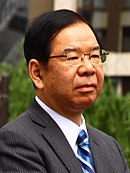
Back الانتخابات العامة اليابانية 2021 Arabic Eleccions generals japoneses de 2021 Catalan Shūgiin-Wahl 2021 German Ιαπωνικές γενικές εκλογές 2021 Greek Elecciones generales de Japón de 2021 Spanish انتخابات سراسری ژاپن (۲۰۲۱) Persian Japanin parlamenttivaalit 2021 Finnish Élections législatives japonaises de 2021 French הבחירות הכלליות ביפן 2021 HE 2021-es japán képviselőházi választások Hungarian
| ||||||||||||||||||||||||||||||||||||||||||||||||||||||||||||||||||||||||||||||||||
All 465 seats in the House of Representatives 233 seats needed for a majority | ||||||||||||||||||||||||||||||||||||||||||||||||||||||||||||||||||||||||||||||||||
|---|---|---|---|---|---|---|---|---|---|---|---|---|---|---|---|---|---|---|---|---|---|---|---|---|---|---|---|---|---|---|---|---|---|---|---|---|---|---|---|---|---|---|---|---|---|---|---|---|---|---|---|---|---|---|---|---|---|---|---|---|---|---|---|---|---|---|---|---|---|---|---|---|---|---|---|---|---|---|---|---|---|---|
| Turnout | 55.97% ( | |||||||||||||||||||||||||||||||||||||||||||||||||||||||||||||||||||||||||||||||||
| ||||||||||||||||||||||||||||||||||||||||||||||||||||||||||||||||||||||||||||||||||
 Districts and PR districts, shaded according to winners' vote strength | ||||||||||||||||||||||||||||||||||||||||||||||||||||||||||||||||||||||||||||||||||
| ||||||||||||||||||||||||||||||||||||||||||||||||||||||||||||||||||||||||||||||||||
| This article is part of a series on |
 |
|---|
|
|
General elections were held in Japan on 31 October 2021,[1] as required by the constitution. Voting took place in all constituencies in order to elect members to the House of Representatives, the lower house of the National Diet. As the constitution requires the cabinet to resign in the first Diet session after a general election, the elections will also lead to a new election for Prime Minister in the Diet, and the appointment of a new cabinet, although ministers may be re-appointed. The election was the first general election of the Reiwa era.
The election followed a tumultuous period in Japanese politics which saw the sudden resignation of Prime Minister Shinzo Abe in 2020 due to health issues and the short premiership of his successor Yoshihide Suga, who stepped down as leader of the ruling Liberal Democratic Party (LDP) after only about a year in office due to poor approval ratings. The period since the previous general election in 2017 also saw the consolidation of much of the country's centre-left into a newly strengthened Constitutional Democratic Party (CDP) and the forming of the left-wing populist party Reiwa Shinsengumi led by former actor Taro Yamamoto.
The LDP, led by new Prime Minister Fumio Kishida, maintained a comfortable majority despite losing seats.[2][3] The primary two left-wing opposition parties, the CDP and the Japanese Communist Party, both underperformed expectations and lost seats relative to their standings in the chamber immediately before the election; this occurred despite both parties cooperating in a significant electoral alliance to avoid vote splitting. The CDP's poor results led to the resignation of party leader Yukio Edano shortly after the election. The Osaka-based conservative party Ishin no Kai gained 30 seats, becoming the third-largest party in the chamber.
Cite error: There are <ref group=lower-alpha> tags or {{efn}} templates on this page, but the references will not show without a {{reflist|group=lower-alpha}} template or {{notelist}} template (see the help page).
- ^ "Voting for Japan's Lower House underway". NHK World-Japan. Retrieved 31 October 2021.
- ^ "Japan's Ruling Coalition Poised to Keep Power Despite Losses". Bloomberg News. 31 October 2021. Retrieved 31 October 2021.
- ^ 日本放送協会. "【時系列まとめ】衆議院選挙 開票速報タイムライン 全議席確定". NHKニュース. Retrieved 1 November 2021.
© MMXXIII Rich X Search. We shall prevail. All rights reserved. Rich X Search




